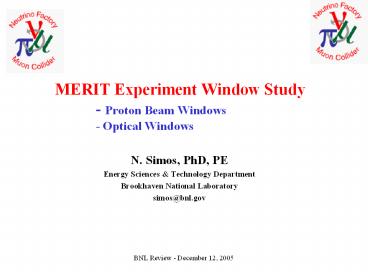MERIT Experiment Window Study - Proton Beam Windows - Optical Windows - PowerPoint PPT Presentation
Title:
MERIT Experiment Window Study - Proton Beam Windows - Optical Windows
Description:
In the 'bigger picture' goal is to benchmark a simulation of the event with test data. ... For the same projectile, neither the 4mm nor the 2mm experience ... – PowerPoint PPT presentation
Number of Views:24
Avg rating:3.0/5.0
Title: MERIT Experiment Window Study - Proton Beam Windows - Optical Windows
1
MERIT Experiment Window Study - Proton
Beam Windows - Optical Windows
- N. Simos, PhD, PE
- Energy Sciences Technology Department
- Brookhaven National Laboratory
- simos_at_bnl.gov
2
MERIT Hg Jet Target Concept Window Integration
3
Baseline Target Assembly Concept
4
Primary Secondary Beam Windows - Baseline
Ti-6Al-4V primary window
SSTL end disk
Ti-6Al-4V disk
Primary window collar to allow welding onto the
thicker disk
Secondary window pair (1mm Ti-6Al-4V)
5
ENSURING THAT Hg is HERMETICALLY ISOLATEDE951
experiment experience
Figure above depicts the tight beam spot
requirement (0.5 x 0.5 mm rms) for target
experiment at AGS Induced shock stress in a
window structure by 16 TP intensity beam and the
spot above will likely fail most materials in a
single short pulse ( 2 ns)
MERIT Experiment Issues with SSTL Windows
6
E951 Beam Window Testing (Al-6061 Ti-6Al-6V
Havar Inconel-718)
7
Beam Window Experimental Studies(E951)
Experimental Strain Data vs. Simulation
8
Ti-6Al-6V tested as beam window with the24 GeV
AGS Beam (3.5 TP) MERIT experiment ?
Ti-6Al-4V Important Tests at BNL showed that
Hg does not attack the aluminum of the
alloy composition.
9
Beam Window Study on T-6Al-4V Establishing
Thicknesses 1mm rms spot assumed in analysis
(smaller than what will be actually seen by the
experiment Windows thus allowing for SF in the
calculations)
10
Beam Window Study on T-6Al-4V and SSTL choices
11
Beam/Window Interaction Analysis What happens if
beam wobbles and catches the edge
12
Beam/Jet Interaction Analysis Nozzle damage from
waves in mercury?
Stresses in the nozzle are small just a few MPa
13
Hg Jet Destruction Viewing Window Safety
Analysis Optical Window Vulnerability
Study Beam-induced Hg jet destruction
In the bigger picture goal is to benchmark a
simulation of the event with test data. The
benefit will be a clear understanding of how
quickly jet destructs and thus provide
information as to how close micro-pulses in the
real muon collider can be stacked
Entering into BALLISTICS !!!!
14
What are we dealing with? Projectile velocity
estimates
Based on beam energy deposition Hg properties
Velocities of 200 m/s are expected
15
Preliminary beam-induced jet destruction analysis
NO Magnetic Field
16
Selecting the appropriate material and thickness
to protect against the worst-case scenario
(projectile with max momentum)
- Sapphire has been selected as the optical window
(excellent strength properties including fracture
8 Joules/m2 ) protect against thru cracks - 6mm thickness (such thickness does not impede the
optics) - Explore other thicknesses for future applications
(2mm 4mm)
17
OVERVIEW OF Sapphire Window
Vulnerability Expertise in ballistics/impacts
and ALE formulations allowed the modeling and
analysis of a series of cases that included the
formation of cracks in the sapphire window The
nominal (6mm) sapphire window does not experience
any kind of failure when subjected to a mercury
droplet of 5mm diameter (half the jet diameter)
traveling at 200 m/s For the same projectile,
neither the 4mm nor the 2mm experience failure in
the form of cracking or penetration Penetration
of the 4mm thick window is possible with a 2cm
diam. Mercury projectile traveling at 400 m/s
18
Hg Droplet IMPACT on Sapphire Window Formulation
- - Employ ALE formulation (LS-DYNA)
- Hg modeled as fluid enclosed in a hyper-thin
hyper-elastic membrane - (surface tension) that bursts upon impact
- - Hg spills and mixes with the surrounding fluid
- - Sapphire is specially modeled so cracks can be
traced if they develop - - Mesh adaptation in the impact region for
sapphire mercury is employed - - Examined 2mm 4mm and 6mm sapphire windows
19
2cm Hg Droplet IMPACT on Sapphire Window
Benchmarking simulations with a planned experiment
20
BASELINE 6mm sapphire window 5mm diam.
Projectile at 200 m/s
21
6mm sapphire window 5mm diam. Projectile at 200
m/s
22
2mm sapphire window 5mm diam. Projectile at 200
m/s
23
4mm sapphire window 2cm diam. projectile at 200
m/s ZOOM IN the region of plastic deformation
(adaptive meshing)
24
Looking for CRACKS 4mm window impacted by a 2cm
diam. Hg-like projectile
4mm sapphire 2cm diam. projectile IMPACTED
face shown small surface cracks
4mm sapphire back face and no cracks
25
(No Transcript)
26
4mm sapphire window 2cm diam. Hg projectile at
400 m/s Looking for penetration limits
27
Displacement Velocity of the projectile tail
28
CONCLUSIVE REMARKS Windows are
SAFE from beam mercury splatter Actual
IMPACT tests on sapphire will be performed to
ensure confidence in the simulations Challenges
of Titanium-to-Stainless welding will be met
(there is always the fall back position of
titanionizing the whole assembly

